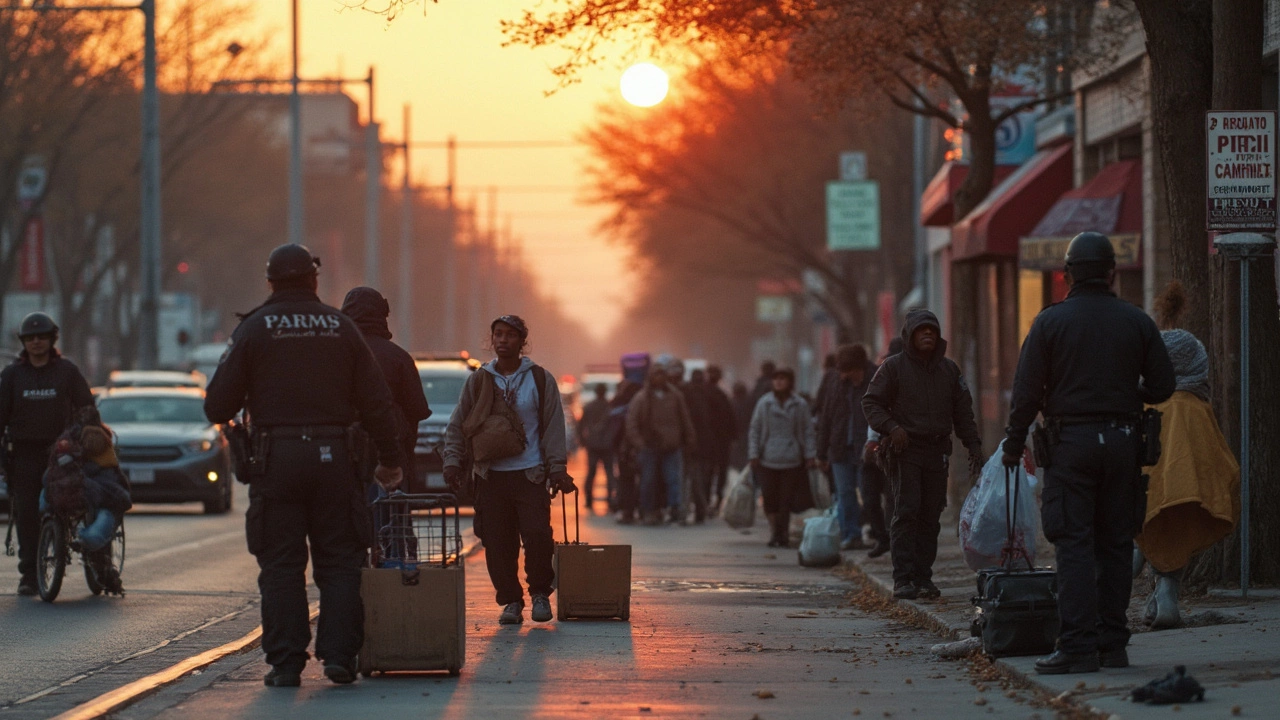Finding yourself without a place to stay can be daunting, but knowing where to find help makes all the difference. From traditional shelters to unique options like micro-housing, we've gathered key insights to guide you. Discover practical tips and surprising facts about safe places that offer not just room and board, but also support and resources. Equip yourself with knowledge that could be lifesaving in challenging times.

- Created by: Lydia Carmichael
- Completed on: 26 Mar 2025
- Categories: Homeless Support
When you're in a tough spot and need a roof over your head, figuring out the first step can feel overwhelming. Where's the best place to start searching for help? It's not just about finding a bed, but knowing the types of resources available can make a world of difference.
Let's talk about traditional shelters. These are often the go-to option for many. They provide a safe place to sleep, meals, and sometimes other essential services like medical care and counseling. The key here is to find a shelter that aligns with your specific needs. Some cater to families, others focus on single adults, and there are those dedicated to specific groups, like veterans or women.
But what if a traditional shelter isn't a fit for you? That's when it's worth thinking outside the box. Micro-housing and tiny house communities are becoming popular alternatives, offering a bit more privacy and independence while still providing the support structure needed. These innovative solutions can be a great step towards stability.
- Understanding the Options
- Traditional Shelters
- Innovative Housing Solutions
- Resources Beyond Shelters
- Making the Most of Available Help
Understanding the Options
Finding yourself in need of a place to stay can be scary, but knowing your options is key to navigating the situation effectively. There are numerous types of shelters and housing solutions out there, and each caters to different needs. Let's break it down so you can figure out what might work best for you.
Different Types of Homeless Shelters
Homeless shelters are the most common and immediate solution. They're usually run by non-profit organizations, religious groups, or government agencies providing temporary housing for those in need. These shelters often offer additional services like meals, access to social workers, and job assistance programs.
- Emergency Shelters: These are designed to provide short-term solutions, offering immediate shelter and protection.
- Transitional Shelters: Aimed at helping people move towards permanent housing by providing a more extended stay along with programs to help with employment and budgeting.
- Day Shelters: While they don't offer overnight accommodations, they do provide services like meals, showers, job finding resources, and a safe place to rest during the day.
Innovative Solutions
Beyond the traditional options, some communities have embraced inventive solutions. Ever heard of tiny house villages? They provide a sense of privacy and community, with shared spaces for cooking and social activities. Micro-housing projects offer similar benefits and are especially popular in urban areas.
Another cool option could be the use of converted spaces. We've seen projects that transform old buses or shipping containers into livable spaces. These not only save resources but also quickly provide suitable housing for those in need.
Choosing the Right Option
So how do you choose? Consider what you need beyond just a bed. Do you require specific support services, like those for mental health or addiction recovery? Are you looking for a place that keeps families together? Think about what's most important to you and prioritize accordingly.
Understanding these options and weighing the pros and cons of each can significantly impact your path to stability. Don't hesitate to reach out to local services to learn more about what's available in your area.
Traditional Shelters
When it comes to finding a place to sleep at night, many people think of homeless shelters first. These shelters offer a crucial lifeline, providing not only a warm bed but often a sense of community and safety. Most shelters are operated by non-profit organizations, local government agencies, or religious institutions.
What to Expect?
Traditional shelters usually offer basic necessities such as meals, hygiene facilities, and sometimes, clothing. Some go the extra mile by providing access to medical care, mental health services, and job counseling. Understanding what to expect helps plan your stay better.
Types of Shelters
- Emergency Shelters: These are for short-term stays and often have less strict entry requirements. Perfect if you need immediate help.
- Transitional Shelters: They offer longer stays, sometimes up to 24 months, with more structured programs to help you transition back to independent living.
- Specialized Shelters: Some shelters cater to specific populations like families, veterans, or women and offer tailored support services.
Finding the right fit for your needs is important. Check local directories or online resources for shelters in your area that provide the services you need.
Stats: Who Do Shelters Serve?
Understanding who makes use of these shelters can be valuable. Here's a quick look:
| Group | Percentage |
|---|---|
| Single Adults | 65% |
| Families with Children | 25% |
| Unaccompanied Youth | 10% |
It's evident that homeless shelters are a vital resource for diverse groups. Whether you're on your own or with family, there's likely a shelter that can meet your needs and help you start rebuilding.

Innovative Housing Solutions
In today's world, finding unique ways to tackle homeless issues is crucial. Innovative housing solutions go beyond the basic shelter model, offering not just a place to stay, but a community and a more stable environment.
Tiny Home Villages
These are popping up across many cities as a novel approach to transitional housing. Tiny home villages provide residents with their own small, private space, offering dignity and a sense of independence. They're usually equipped with basic amenities: a bed, small kitchen, and bathroom facilities. But the magic happens in the community setting, where residents have access to shared services and community support. In Portland, for example, Dignity Village offers a sustainable, community-driven approach allowing residents to take part in governance and maintenance, fostering independence.
Container Homes
You wouldn't believe it, but those big metal shipping containers you see at ports can be transformed into cozy homes. Container housing is gaining traction due to its affordability and quick setup. They might look industrial from the outside, but inside, they come equipped with all you need. Los Angeles has taken to these structures, providing stylish, sustainable living spaces in areas where traditional housing would be too costly or slow to develop.
Converted Motel Programs
Sometimes, the answers are right under our noses. Cities like San Diego have taken old motels and revamped them into emergency housing solutions. This approach is quick and cost-effective, offering immediate respite for those in need. Motels are already equipped for living, so a few tweaks make them ideal as temporary shelters, often added with services for mental health and job training to help residents transition back into permanent housing.
These innovative housing solutions show that there are powerful ways to provide more than just a bed. They create communities, support networks, and a sense of hope. As more cities adopt these methods, we can get closer to solving the issue of homelessness, one creative solution at a time.
Resources Beyond Shelters
When thinking about homeless shelters, we often picture dormitory-style setups, but there's much more out there if you know where to look. Beyond these traditional shelters, several resources can help you get back on your feet.
Community Centers and Libraries
Community centers and public libraries might not be the first places you think of for housing, but they offer valuable resources. Many provide access to computers for job hunting or free Wi-Fi to stay in touch with family. Some libraries even partner with local organizations to offer workshops, ranging from resume building to health awareness sessions.
"Libraries are not just about books. They are a key resource for today's homeless, providing a safe haven and access to essential tools for rebuilding their lives," says Alex Johnson, a community service coordinator.
Health Services and Food Banks
Your well-being is crucial, and many cities offer free or low-cost health clinics and food banks. According to a recent survey, over 70% of homeless individuals can access at least one meal a day through food banks. Many places also distribute essential toiletries and clothing—making a big difference in personal hygiene and comfort.
Employment Services
Finding steady work can dramatically change your situation. Look into local job centers or vocational training programs specifically tailored for the homeless. They often provide workshops, one-on-one coaching, and connections to employers open to hiring people with less traditional backgrounds.
| Resource | Service Provided |
|---|---|
| Library | Internet access, educational workshops |
| Health Clinic | Medical care, mental health support |
| Food Bank | Meals, toiletries, clothing |
| Job Center | Resume help, job placement |
With these finding shelter alternatives and supports, you can carve out a path to stability. It's all about knowing where to look and making the resources work for you.

Making the Most of Available Help
Once you've found a shelter or housing solution, it's crucial to leverage all the support offered. Many homeless shelters provide more than just a bed and a meal. They often have a range of services that can help you get back on your feet. Let's dive into how you can take advantage of these resources effectively.
Engage with On-Site Resources
Most shelters have staff or volunteers who can connect you to job training programs, healthcare services, and even mental health support. Don't hesitate to ask about workshops or classes that can boost your skills—they're often free. Joining these programs can increase your chances of finding work and can be a big help towards regaining independence.
Networking Opportunities
While you’re staying at a shelter, you’re in a unique position to build a network. Talk to the staff and other residents, who may have valuable advice or know about local job openings. Sometimes, the right connection can lead to the perfect opportunity.
Accessing Financial Counseling
Many shelters partner with organizations that offer financial planning and advice. These partners can guide you in budgeting and financial management, which are crucial when planning for long-term housing. Taking advantage of these sessions can make a significant difference in your financial stability.
Health and Wellness Check-ins
Staying healthy is key, and shelters often have clinics or connections to free healthcare services. Regular check-ups, dental care, and vaccinations can keep you in good shape, which is important when searching for or maintaining employment.
| Service | Availability |
|---|---|
| Job Training | 85% of shelters |
| Healthcare Services | 70% of shelters |
| Mental Health Support | 60% of shelters |
In short, making the most of what's offered at emergency housing can be a game-changer. By actively participating and utilizing these resources, you're not just surviving—you're setting yourself up for a brighter future. Remember, the first step is reaching out; the rest can follow from there.
Texas has brought in new laws affecting homeless people and the way shelters operate. This article breaks down the most recent rules, explains what people living on the streets need to know, and sheds light on how shelters are responding. Readers will learn about bans on public camping, ID policies, and fines, plus how shelters are adjusting services to match legal changes. Practical tips help anyone looking to understand, navigate, or help with the new legal landscape.
Discover the most requested items by people experiencing homelessness and why they matter. From hygiene products to socks, these necessities make a significant impact. Learn how you can help and make thoughtful contributions that truly benefit those in need.

